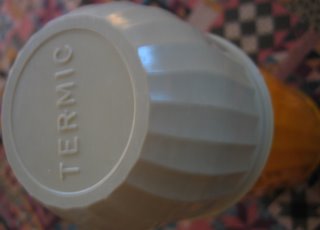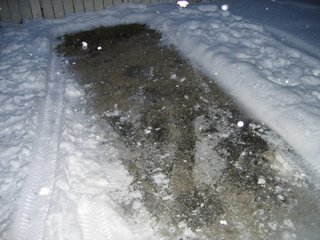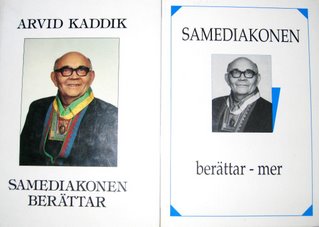Tuesday, April 17, 2007
http://earthseablog.wordpress.com/
See you there!
The Beaver
Saturday, February 03, 2007
 Chol-Chol February 2001
Chol-Chol February 2001We got off the bus in this little sleepy town, coming from Temuco, the cultural capital of the Mapuches. Our guidebook mentioned a museum in this town but no-one we asked had heard about it.
At last we found the modest local museum right across the street when we returned to the bus stop. There the traditional ways and handicrafts of the Mapuches were shown, and a ruca, a traditional sedge-house, was re-created.
Saturday, January 27, 2007
 Lindberg revisited - Plastic design
Lindberg revisited - Plastic designAs I was staying at a nearby hotel, I had a couple of hours free so I could not resist seeing the Stig Lindberg exhibition at Nationalmuseum again (see September 30 entry).
This time I watched the 3 short movies that were run continuously. One of them, "Industry visit" from Swedish television on April 25 1957 was an interview with Lindberg. He talked about Gustavsberg as a creative place. At this factory, plastic was an important industrial material so it was natural also for the ceramics designers to work with it and create beatiful and functional every-day things. (They did not themselves talk about beauty, only of "smartness".)
Lindberg became one of the pioneers for design in plastic. One example was the thermos "Termic" which was produced from 1957 until 1975! It was found in most Swedish homes over 2 generations.
Friday, January 19, 2007

Stig Lindberg - the Joker and the Lady
The Karneval series from 1958 - 1962 is typical Lindberg imagery. It contains a large number of images - trays as well as vases. The series is now popular for collecting and I have noted that prices in England and USA on these and other Lindberg works are even higher than in Sweden. One sales site is found here.
It is supposed to be a kind of reminiscence of the faience period at Gustavsberg ceramic factory up through the 50's. It is however made in serial production and not individually designed items.
The harlequin can be compared to the joker of the deck of cards (See entry Dec 28). This one has a more childish and innocent appearance. Maybe he has escaped from one of Picasso's circus paintings.
Sunday, January 14, 2007
 Winter, finally?
Winter, finally?The ground under my car still did not bear any witness of snowfall as of this morning. And at the coast, there has been less ice this January than ever, since mid 1800's when records started. Today, though, it seems that winter is catching up at last.
Storm has hit southern Sweden today, even resulting in casualties. Up North, we are not so unfortunate, and only have a reasonably heavy snowfall. It feels as if time has turned right. Now just let us see if the white cover will stay with us.
Wednesday, January 10, 2007
 A Russian to remember
A Russian to rememberJevgenij Zamjatin is an early 20th century Russian author who deserves a better fate than to be forgotten. Therefore it is excellent that one of his short novels, "The story about the most important", recently has been translated to Swedish and published by the small editorial Ruin.
I have already mentioned the science fiction novel We by Zamjatin (November 22 entry). This is an amazing work in many aspects. We are now presenting some more of his writing from the insect perspective, and in particular the new book which has a central insect theme.
Just like Jan Larri (see June 14 entry) he was bold enough to write to Stalin. Writing without restraining himself, and publishing We abroad, he ended up accused of being counter-revolutionary, although he had long been a devoted communist. Surprisingly he survived and was allowed to emigrate.
Read more in part 26 of the Literature history of insects in the recent issue of Natur i Norr! (In Swedish)
Drawing by Juri Annenkov 1921
Saturday, January 06, 2007

Mussels and Caviar - Chiloë 2001
Chonchi is known as la ciudad de los tres pisos because of its peculiar topography. In this harbour town we found some of the best seafood in all of Chiloë (and Chile). At restaurant El Trebol, we had very fresh and fine Mussels in Salsa Verde, and delicious Locos.
At another place, we started a conversation with three young men who all worked in the salmon industry. One of them suddenly disappeared, only to return after a while, bringing a small plastic package with Japanese writing. He gave us the package and asked us to taste the content. The guy had gone back to his work to get a sample of salmon caviar, produced for the Japanese market. It was very good, almost like Russian caviar, but, of course, bright red.
Thursday, December 28, 2006
Petrus Laestadius tells in his journals about the harsh years in 1828 to 1832 when all bad fortune gathered over Lapland. Most of all, there was hard crust on the snow (called tjocke, tjuocke, or, in Swedish, flen, by Laestadius), preventing reindeer from grazing. “It can be supposed that the Mountain-lapps' reindeer herds in Arjeplog, in this one year (1828), were diminished by at least one third. Rich Lapps became poor, and those who earlier had small reindeer-herds became unable to sustain as Nomads, so that many left for Norway and settled there.”
In the coming years, there were many wolves, preying on the reindeer and scattering them, and much lemmings consuming the alpine forage. There were also forest fires, and summer frost.
In 1832 there was another winter of tjuocke. “Of the Lapps, who actually are my people, the best part, the Forest‑lapps, have been almost totally ruined: their want is incomparable to that of any others. The reindeer-herds of the Mountain-lapps are at least halved: so hard times must have been rarely occurring.”
Tjuocke is actually a problem also in the present winter 2006/2007. In our county 50 000 reindeer may need to be transported by truck to the coast. Even if the effects will be less dramatic nowadays – no people will starve to death – the costs for supplemental feeding will be serious enough.
In the excellent book “Snö” by Yngve Ryd where the Lule Sámi vocabulary on snow is explored, the tjuohke phenomenon is analysed also. It is a crust of ice that entirely locks the lichen forage so grazing is impossible. It forms already in the autumn and does not melt until spring. It is the worst possible winter condition for the reindeer.
 Stig Lindberg - the deck of cards
Stig Lindberg - the deck of cardsI told about the Stig Lindberg-designed deck of cards, that we sometimes played with (in the September 30 entry). It really stands out among card decks for its bold design. There was one deck with blue back side, and one with red. The blue one, which had been retrieved from a poker-playing uncle, I saw again this Christmas day.
Here is just the Joker, which by the way carries the same pattern as the back side - the very typical Lindberg harlequin pattern. The series is called "Comedia" and was released by Öbergs playing card factory in 1958. It was reprinted again later, in the 70's maybe, but does not seem to be available in stores any longer. An unused deck, supposedly the original version, can be bought on the Internet for 650 SEK.
More about Stig Lindberg can be read here .
Sunday, December 17, 2006
 Winter again?
Winter again?Winter came in October and left again in November. Now fínally we are having 5 degrees below zero. The archipelago garden is frosty but not snowy. Dry lily stalks still stand upright carrying their seed capsules like little bells.
The rowans are waiting for the moose to take their yearly toll of top shoots. Waxwings swarm and ring aginst wintery clouds.
Will winter stay? Or is it just another joke?
Saturday, December 16, 2006

Meanwhile, in Norrland….
Two famous travel diaries overlap in 1831-1832. These are Darwin’s travels on board the "Beagle” 1831-1836, and Petrus Laestadius’ mission travels in Norrland 1827-1832. Although the former has a greater fame internationally, also Laestadius is well worth reading. He was born in Arjepluog in 1802 and as a small child he was raised under incredibly miserable conditions.
Much thanks to the efforts of his elder half brother, who was a priest in Kvikkjokk, Petrus came to be educated in theology in Uppsala and came into contact with modern ideas including Kantian philosophy. Laestadius returned to Lapland and became a missionary. His journals are still very readable, and give much more information on local nature and culture than other similar sources, for example Linnaeus’ Laplandic account, since he was of local origin and a fluent Sámi speaker.
Thursday, December 07, 2006
We got another good advice from Francisco Roca, and this was about what to do in Valparaíso. This was to visit the Nordic School. There is a Swedish folkhögskola (Biskops Arnö) giving a film course for young Swedes, many with a Latin American background, Escuela Nórdica de Cine Documental.
We visited the school together with our friend. This was a very good place, situated high over the town on one of the many hills which are reached by the elevators (ascensores). We saw some student productions, many bringing up difficult subjects such as social injustice and sex among young people in Chile, and talked with the teachers. (I think the students were somewhere else at that time because we didn’t meet them.)
The students live for a year in Valparaiso meeting local young people and interviewing and making film with and about them. In this way they learned a lot about making film, about people, about Valparaíso, Chile and Latin America, and not least, a lot about themselves and their own background.
Picture by Julia Lundberg, student at the school
Tuesday, December 05, 2006
 Crossroads – Arvid Kaddik in Arjepluog
Crossroads – Arvid Kaddik in ArjepluogAn elderly person I know well told the other day about how Arvid Kaddik (see October 18 entry) came to her village every Christmas in the mountain area of Arjeplog parish to give a sermon. Then there was also a reason to have a Christmas party for the whole village.
Kaddik, a deacon, was deeply religious and something of a mystic. He was of Sàmi origin and born in 1904. He first was aducated to be a teacher and then studied theology. He travelled all his life among the Swedish Sàmi people and was loved everywhere for his kindness. He was also important for promoting Sàmi culture – and it was in this role he took part in the meeting in Yttervik, where I got the chance to meet him.
He wrote down his memories in two volumes 1989 and 1992.
Monday, December 04, 2006
 Sour Fish 7 - The Concept
Sour Fish 7 - The ConceptContinuing the series from August, here is a new marketing concept for sour herring from Ulvö Little Saltery under the brand Eric the Red. The idea seems to be that this fish is a viking food with "sybaritic aromas and sublime taste".
The fish can is packed in a box with a nicely designed leaflet in Japanese and several other languages. It is sold together with similarly branded bread and beer from other local producers. Maybe this new branding idea can recruit new sour herring fans?
How it tastes? I didn't open the can yet - as I wait for some special occasion...
Thursday, November 23, 2006

Archipelago Crafts - the result
After a number of working hours a number of boots and bags were produced, in various styles and sizes. Leather and pelts of various kind was used, but the base was seal skin. Traditionally here, the sole of seal skin boots was made by horse skin, with the hairy side out for better grip. The seal skin was then not tanned, just scraped and dried.
Neather is the Inuit way of preparing seal skin proper tanning, but instead the skin is softened physically, by chewing or by using a tool.
The old people in the archipelago still remember how they used to make their own boots. They were warm, and if treated with tar water on the inside, they were quite water resistant too. It seems that the women deserted the seal boots before the men did. Maybe sealskin shoes were too rustic and old-fashioned - girls wanted something more modern and fancy to put on their feet.
Of course,with the coming of rubber boots, the time was up for seal skin footwear.